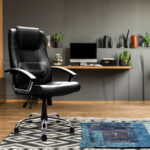This post contains affiliate links, and we will be compensated if you buy after clicking on our links.
Whether delicately positioned behind your back on your favorite chair or offering relief during those long drives, lumbar pillows play an invaluable role in our daily lives.
They not only enhance our comfort but also support our spines, making sedentary tasks more bearable.
Just like any other daily accessory, these ergonomic saviors collect sweat and dirt. Cleaning them incorrectly can lead to a decrease in their supportive function or even shorten their lifespan.
In this article, we’ll guide you through the steps on How to wash a lumbar support pillow, ensuring it remains a source of comfort and support.

How to Wash a Lumbar Support Pillow
1. Understanding the Care Label
Before embarking on the cleaning journey, it’s paramount to first inspect the care label attached to your backrest pillow.
This label is a treasure trove of information, guiding you on the best cleaning methods suitable for the fabric and fill of the pillow.
It will clearly indicate if the pillow is amenable to machine washing or if it strictly requires professional dry cleaning.
2. Detaching the Pillowcase
Many backrest pillows come equipped with a removable cover or case, designed to protect the inner cushioning.
If your pillow has such a feature, gently unzip or unbutton it and separate the case from the pillow.
This allows for a thorough cleaning of both the cover and the pillow itself. If your pillow doesn’t have a detachable case, worry not, and simply move on to the next step.

3. Vacuuming the Pillow Surface
With time, pillows can accumulate dust, pet hair, and tiny debris. To tackle this, use a vacuum with a gentle brush attachment.
Carefully vacuum the whole pillow surface, making sure to reach every corner, preparing it for a thorough cleaning.
4. Addressing Stains and Spots
Spills and stains happen unexpectedly. To address them, create a mild cleaning mixture using a gentle detergent.
Moisten a soft cloth with this mixture and lightly dab the affected spot. It’s essential to refrain from aggressive scrubbing, as it might worsen the stain and possibly damage the material.
5. Machine Washing the Lumbar Pillow
If, and only if, the care label gives the green light, you can proceed to machine wash the pillow. Opt for a gentle washing cycle to preserve the integrity of the pillow’s structure.
Pair this with a mild detergent and cold water to ensure a gentle yet effective cleanse.

6. Hand Wash the Lumbar Pillow
If you prefer hand washing or if the care label suggests it:
- Fill a tub or basin with lukewarm water and add a small amount of mild detergent.
- Gently agitate the water to create suds.
- Submerge the pillow, gently pressing it to ensure the detergent penetrates the fabric.
- Rinse thoroughly with clean water until all the detergent is washed out.
- Gently squeeze out excess water without wringing the pillow.
- Lay the pillow flat on a clean towel and roll it up to absorb more moisture. Then, air-dry the pillow in a well-ventilated area.
7. Drying the Lumbar Pillow Post-Wash
Once the washing is complete, the pillow needs to be dried thoroughly to prevent mold and mildew formation.
If you’re using a dryer, select the lowest heat setting to prevent any potential shrinkage or damage.
Alternatively, for those sunny days, consider air drying the pillow outdoors, ensuring it’s completely dry before use.

Why Clean Your Lumbar Pillow?
- Health and Hygiene: Regular cleaning removes dirt, dust, and allergens, reducing the risk of allergies or skin irritations.
- Pillow Longevity: Cleaning prolongs the pillow’s life, ensuring it remains comfortable and supportive.
- Prevent Bacterial Buildup: Regular cleaning prevents the growth of bacteria, mold, and mildew, which can be harmful to health and cause unpleasant odors.
What if The Lumbar Pillow has Mold?
Mold on a pillow is a health concern and should be addressed promptly. If your pillow has visible mold or a musty odor, it’s best to first assess the extent of the mold growth.
For minor mold spots, you can clean the pillow with a mixture of equal parts water and white vinegar, which acts as a natural mold killer.
After cleaning, ensure the pillow is thoroughly dried in direct sunlight, which also helps kill mold spores.
However, if the mold infestation is severe or if the pillow has a persistent musty odor even after cleaning, it might be best to replace the pillow for health reasons.
Always ensure your pillow is completely dry after washing to prevent mold growth in the future.
➤Learn More about how to remove mold from pillows – click here
Conclusion
Keeping your backrest pillow clean is not just about making it look good or last longer. It’s about making sure you have a clean and safe place to relax.
By using the guide given, you can keep your pillow in good shape and also protect your health.
FAQ
How often should I clean my backrest pillow?
It’s recommended to spot-clean any stains immediately and to give your pillow a thorough cleaning every 3-6 months, depending on usage.
Can I bleach my lumbar pillow to remove stubborn stains?
Always refer to the care label before using any strong detergents or bleach. In general, it’s best to avoid bleach as it can weaken the fabric and cause discoloration.
What if my pillow doesn’t have a care label?
If your pillow lacks a care label, it’s safest to spot-clean and air dry. If machine washing is necessary, use cold water on a gentle cycle and air dry to prevent potential damage.
Can I use fabric softeners when washing my backrest pillow?
While fabric softeners can make the pillowcase feel softer, they might reduce the absorbency and breathability of the fabric. It’s best to avoid them or use them sparingly.
Related Articles









